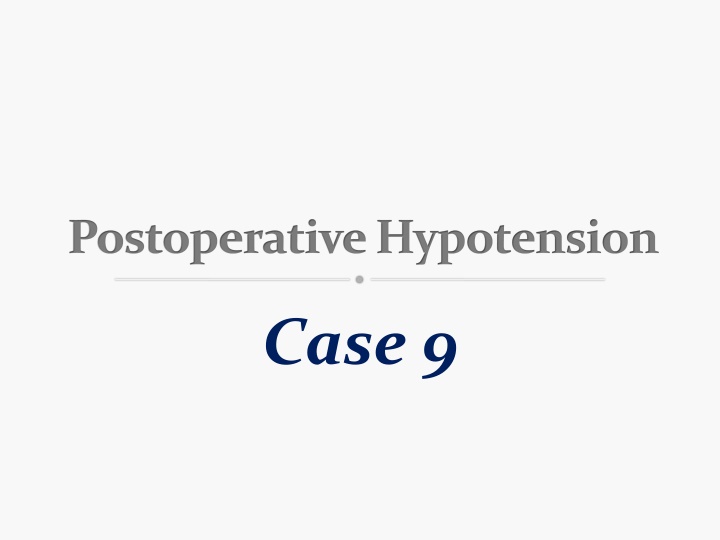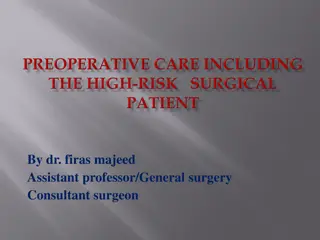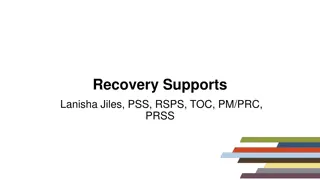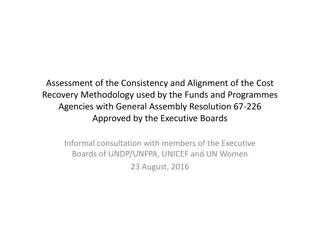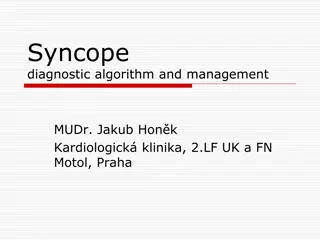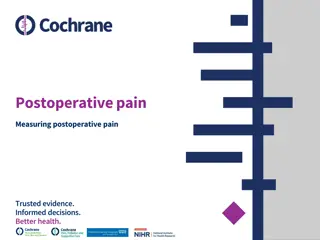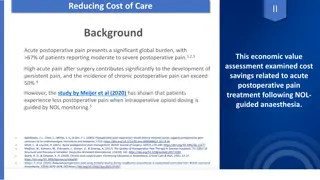Postoperative Hypotension: Management and Recovery Strategies
In a case of postoperative hypotension following a transurethral prostatectomy under spinal anesthesia, a 78-year-old patient presented with agitation and shivering in the PACU. Vital signs and pain scores were monitored, showing a blood pressure of 89/40, heart rate of 85/min, and respiratory rate of 23/min. Assessment plans focused on color, respiration, circulation, consciousness, and activity. The recovery process included monitoring for airway obstruction, hypoxia, hemorrhage, postoperative pain, shivering, and other potential complications. Strategies to address intraoperative heat loss were also discussed, focusing on radiation, convection, evaporation, and conduction as ways the body loses heat.
Download Presentation

Please find below an Image/Link to download the presentation.
The content on the website is provided AS IS for your information and personal use only. It may not be sold, licensed, or shared on other websites without obtaining consent from the author.If you encounter any issues during the download, it is possible that the publisher has removed the file from their server.
You are allowed to download the files provided on this website for personal or commercial use, subject to the condition that they are used lawfully. All files are the property of their respective owners.
The content on the website is provided AS IS for your information and personal use only. It may not be sold, licensed, or shared on other websites without obtaining consent from the author.
E N D
Presentation Transcript
Postoperative Hypotension Case 9
Case.. 78 years old patient attended as inpatient transurethral prostatectomy under spinal anesthesia known case of diabetics and hypertension on treatment , when the patient came to postoperative care units (PACU) patient was agitated shivering.
What are the routine monitor in PACU? Vital signs. Respiration: RR/min, Rythm Pulse oximetry Circulation: PR/min & Blood pressure ECG Level of consciousness Pain scores
Pain scores: Numerical pain rating scale: Modified wong baker faces scale:
Continue The patient blood pressure was 89/40 , HR: 85/MIN , RR: 23/ MIN SPo2 difficult to read because of patient shivering.
What is your assessment plan? Color , Respiration, Circulation, Consciousness, Activity
Look out for the following in recovery: Airway obstruction Hypoxia Haemorrhage: internal or external Hypotension and/or hypertension Postoperative pain Shivering, hypothermia Vomiting, aspiration Falling on the floor Residual narcosis
Discuss the way for intraoperative heat loss The body loses heat in four ways: Radiation 40% Transfer of electromagnetic energy between two bodies of different temperature . 1 Convection 30% Energy transfer will be greater if the air immediately adjacent to a patient skin is repeatedly disturbed . 2
Evaporation 25% As water becomes vapour, heat energy is lost as latent heat of vaporization. This type of heat loss will be increased if a large surface is exposed to evaporation, e.g. loops of bowel during a laparotomy. Surgical skin prep increases heat loss in this way. 10% is lost via respiratory water vapour 3 Conduction 5% Transfer of heat energy by direct contact between two objects of differing temperatures, e.g. a patient being in direct contact with the operating table. A patient lying in a pool of fluid or wet sheets will lose an increased amount of heat via conduction . 4
Methods to maintain temperature in anesthetized patient
Anesthetic machine. Low gas flows and use of soda lime (exothermic reactions) both help with heat conservation. lie on a warmed mattress Warmed blankets. Simple and effective for short cases. Warmed/humidified gases: A heat and moisture exchange filter is usually incorporated into the breathing circuit. This absorbs heat and water vapourfrom exhaled respiratory gases and helps warm and humidify the next delivery of gases to the patient. It is not as effective as active warming methods. Ambient temperature. In modern operating theatres temperature can be accurately controlled and should be at least 21 C.
Continue.. Fluid warmer/warmed fluids. If >500mL of fluid is given it should be warmed to 37 C using a fluid warmer, as should all blood products. Forced air warmer. This blows warm air into a double-layered sheet that covers as much of the patient as possible. Silver-lined space blankets/hats. These reduce radiation heat loss.
What are the causes for post-operative shivering? Postoperative shivering can occur due to: 1 Hypothermia 2 General anaesthesia itself 3 Regional anaesthesia (e.g. spinal or epidural anaesthesia).
What is your management plan? Treatment of Hypotension: Vasopressors Initially treat with fluid bolus (Main treatment of hypotension is fluid replacement ) Correction of the cause: You must know the cause in order to treat accordingly (deficit from OR/ bleeding or cardiac cause/regional anesthesia) If cardiac cause Dysfunction: do all cardiac related tests, consult cardiology.
Discuss the drugs that used to prevent and treat shivering 1 Pethidine 2 Ondaserton 3 Propofol 4 Doxapram 5 Anticholinesterase, e.g. physostigmine
THANK YOU! Group D
